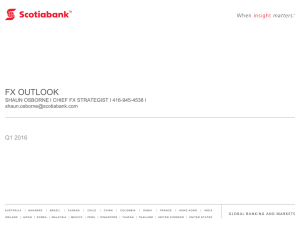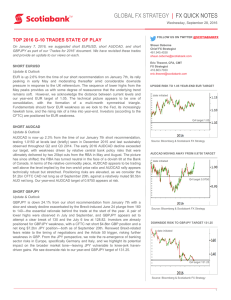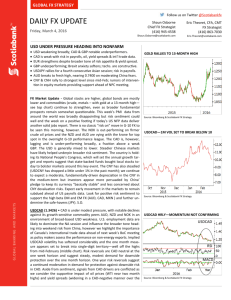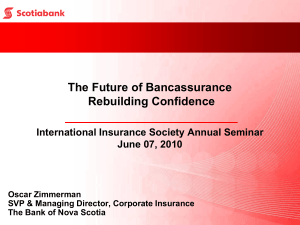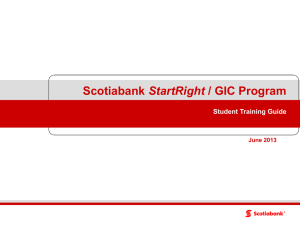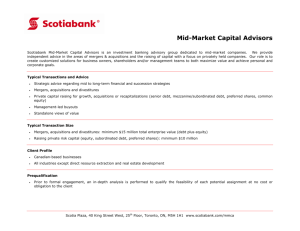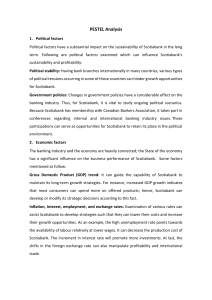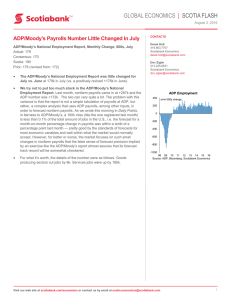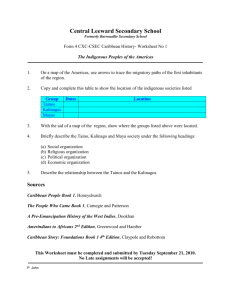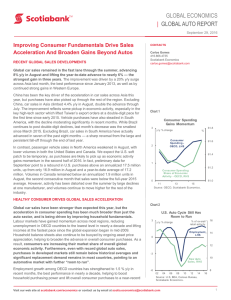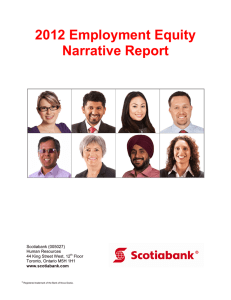the americas in a changing global economic picture
advertisement
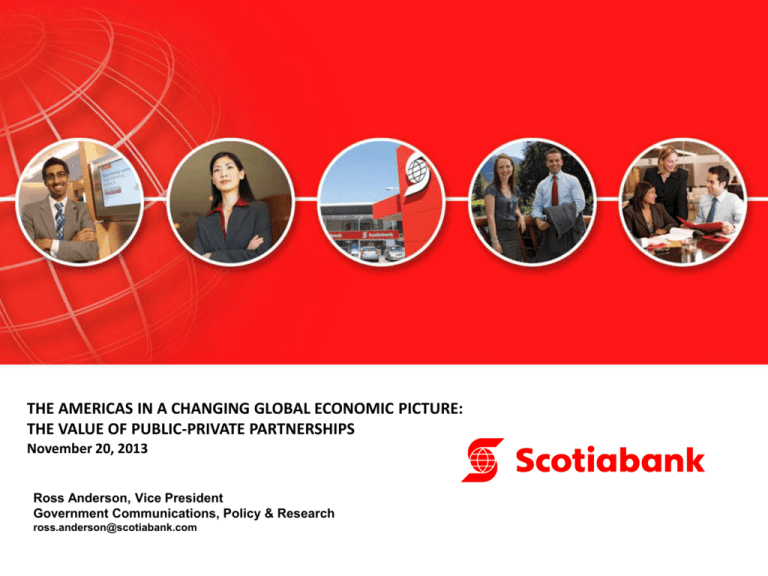
THE AMERICAS IN A CHANGING GLOBAL ECONOMIC PICTURE: THE VALUE OF PUBLIC-PRIVATE PARTNERSHIPS November 20, 2013 Ross Anderson, Vice President Government Communications, Policy & Research ross.anderson@scotiabank.com Outline • Scotiabank in the Americas • Three forms of partnership 1. 2. 3. 2 Investment Corporate Social Responsibility Economic development • Focus on consumer & micro finance • Thoughts on partnerships Scotiabank’s footprint 83,000 employees 21 million customers 55 countries 3 Expansion through the crisis 4 Scotiabank in the Americas Operations • Largest footprint of any Canadian bank in the Americas • Active in Caribbean for 125 years and in Latin America for more than 40 years • More than 61,000 employees in 35 countries • Network of 2,153 branches • More than 7.3 MM customers • Leading financial institution in the Americas providing clients with commercial, corporate, trade finance, correspondent banking and investment services • Established capital market operations and lending relationships in Brazil, Chile, Costa Rica, Colombia, Dominican Republic, Jamaica, Mexico, Panama, Peru, Puerto Rico, Trinidad and Uruguay • Dedicated emerging markets group, with seasoned market professionals, providing services related to emerging market cash bonds, foreign exchange, interest rate derivatives, credit derivatives, equities and commodities • Established global infrastructure platform, with a strong reputation in the Americas 5 Our focus on the Americas Stability Growth Demographics Young demographic entering the workforce Growing middle class Macroeconomic fundamentals and strong growth rates New and expanding client base Following our customers • Good governance and political stability • Historical, cultural ties, trade agreements • Good political relationships and investment framework • Effective supervision and prudential regulation Increased savings and investment 6 Public-private partnerships… …for economic and social development: tackling poverty, increasing prosperity and stability A broader discussion than P3s and long-term project financing, although this is an important area to develop Focus today on three forms of partnership that we maintain with the governments and communities where we operate: 1. Investment 2. Corporate Social Responsibility 3. Economic development 7 Partnerships: Investment Scotiabank’s investments throughout the region are a partnership with governments, where we bring: Strong, deeply rooted risk culture and high standards for corporate governance Prudent, competitive pressure and best practices to credit markets, capital markets, savings, insurance and retirement A focus on making our bank local, whichever market we are in Partnerships with local institutions to build incrementally with a long-term outlook An international perspective, to share expertise, develop leaders Strong relationships with communities, regulators and governments where we operate 8 Partnerships: Scotiabank CSR Regional HIV-AIDS Testing Day (ongoing) Caribbean Broadcast Media Partnership on HIV-AIDS and regional ministries of health to conduct counselling and confidential testing in select Scotiabank branches In 2013, more than 11,808 people were tested in the Caribbean, at 183 sites in 21 countries Scotiabank El Salvador (2012) Brock University, the University Pedagogica of El Salvador and El Salvador’s Ministry of Education on a physical education program for children and youth Included themes of conflict resolution, team work, personal responsibility in the national curriculum 9 Scotiabank’s global philanthropic plan Relevant and responsive at grassroots level Focus on education, healthcare, social services, arts and culture, sports and environment In 2012, more than CAD$53 million Scotiabank employees also contributed more than 500,000 hours of volunteering to local causes In the Caribbean and Latin America, the program focuses primarily on children and children's causes. Partnerships: Scotiabank & economic development “Security is one of our priorities, but the others are creating formal jobs and reducing poverty. They are all connected. - Juan Manuel Santos, President of Colombia Fall 2011 Those connections provide common cause for the public and private sectors Business has a comparative advantage in creating and expanding economic opportunity Recognize there is a double bottom line of positive financial returns and economic/social benefits The poor require a range of financial services: safe, accessible savings; microcredit; payment services; insurance Accessing those services provides huge benefits in terms of security, stability and leverage for disadvantaged populations 10 Financial inclusion and financial services In most developing countries access to formal financial services is limited to 20-50% of the population. These numbers capture not only the poor, but also the near poor who have difficulty accessing the formal market. The banking sector contributes to economic development in four ways: 1. Directly provides economic and social benefits by being a successful business, employer and corporate citizen 2. Indirectly provides these benefits by enabling other businesses to succeed through the provision of credit and through the banking system which lowers transaction costs 3. Directly alleviates poverty and contributes other social benefits by providing access to basic banking services in a formal market and acting as a force of inclusion 4. Indirectly provides these benefits by enabling other inclusive businesses and impact investors through the provision of credit 11 Overview of Consumer and Micro-Finance Micro-finance Consumer Finance Borrowing for working capital, inventory or other business needs Loan size: $1,000-$6,000 Borrowing to purchase consumer goods such as furniture & appliances Loan size: $300-$2,000 In August 2012, Scotiabank located its segment management team in Peru, our centre of expertise on CMF. The team will lead Scotiabank’s strategic direction in CMF across our international footprint. 12 CrediScotia Credito Familiar Mexico CrediScotia launched in Peru in 2009 and now services Peru, Chile, Mexico, DR and Jamaica Diversified product suite for microbusiness owners, lending funds for working capital, acquiring business premises and buying equipment Provides free financial literacy programs to clients and non-clients Consumer Finance operation with 246 branches & robust infrastructure acquired in 2012 Leverages Peru’s CMF expertise Positioned to serve lower-income segment: • 16 million households Significant share of population & economy Nearly 50% of LATAM’s +200MM population, and 30% of the Purchasing Power, is concentrated in this segment Mexico Peru Chile Colombia Dominican Republic (% of Local Population) 13 Affluent 6% 4% 8% 3% 2% Mass Market 29% 15% 15% 32% 11% Consumer & Micro Finance 37% 53% 57% 41% 38% Unbanked 28% 28% 20% 24% 49% Total 100% 100% 100% 100% 100% Additional thoughts on partnerships Investment climate: Already attractive and mature. Continue to develop strengths by emphasizing the following: Transparency, consultation, legal certainty and dispute settlement Don’t compete, do research, fill gaps and graduate to the private sector Policy continuity and coordination (regulatory harmonization or mutual recognition) Corporate Social Responsibility: Opportunities for better coordination and joint efforts across governments, NGOs and private sector actors on common causes, building on the respective strengths of the public and private sector Inclusive growth: Doesn’t work if it’s high risk, low return: CMF is a for-profit, self-funded business – no interest in subsidy but sustainable profits are necessary for stability and scalability High transaction costs coordinating multiple agencies and respective roles Market need is in area of risk mitigation Invest in infrastructure to facilitate market-formation in the financial sector (e.g., secured transactions reform, payments and clearing, risk-sharing) Increase capacity for spillover through literacy, training, technical assistance 14

